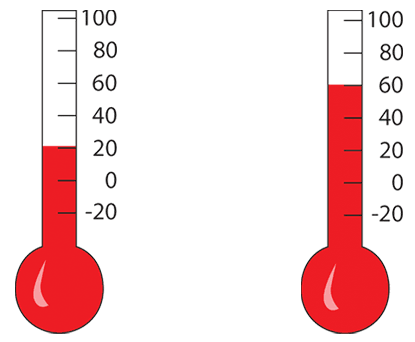Physics in a Bottle: Expanding Thermometers
 Knowing the temperature outside is important if you live in Washington, DC; Chicago, IL; or one of the many other places where the temperature can change by 30 degrees from one day to the next. Want to make your own thermometer? Read on to find out how.
Knowing the temperature outside is important if you live in Washington, DC; Chicago, IL; or one of the many other places where the temperature can change by 30 degrees from one day to the next. Want to make your own thermometer? Read on to find out how.
What you Need
- Bottle of water at room temperature
- Modeling clay
- Straw
- Food coloring
 What to Do
What to Do - Add dark food coloring to the water in the bottle, this will make it easier to see a change in temperature.
- Take a blob of clay about the size of the bottle cap and roll it into a cylinder around 5 or 6 inches long. Then flatten it out so it’s shaped like a ribbon.
- Roll the ribbon of clay around the center of your straw, until the center is about as big as the opening in the bottle.
- Put the straw in the bottle and use the clay to seal it in place, as shown in the picture. Push the clay into the neck of the bottle until the water level in the straw rises an inch or two above the clay.
- Put the bottle in direct sunlight for a few minutes – what happens to the water level? Put the bottle in a bucket of cold water – what happens to the water level?
What’s Going On?
Water is made of molecules. The molecules in water, like in all substances, are constantly moving around – this means that they have kinetic energy. Molecules with more kinetic energy move around faster than molecules with less kinetic energy.
Kinetic energy is related to temperature. The molecules in a glass of warm water have more kinetic energy (they move faster – see Racing Molecules) than the molecules in a glass of cold water. The temperature of a substance is the average* amount of kinetic energy its molecules have.
How does your thermometer measure the average kinetic energy of its water molecules?
Your thermometer doesn't measure energy; it actually measures volume. When a liquid is hot the molecules move around faster and bump into each other and the walls of the container more often and harder than slower moving molecules do. One result of this is that a hot liquid will expand in direct proportion to its temperature. The easiest way for the water in your bottle to expand is for some of it to move up in the straw.
When the water cools down, the liquid will contract and the water level will go down. Since the volume change is directly related to the temperature in both cases, your thermometer can tell you the temperature change by measuring the volume change!

The volume of liquid in an expansion thermometer depends on the temperature of the liquid. If two thermometers start out at the same temperature and then one is put in a hot environment and one in a cold, their volumes will change. A scale on the side of a thermometer shows how volume is related to temperature.
*The molecules in a liquid don't all have the same amount of kinetic energy even when the liquid is at a specific temperature.
Try This!
- Replace the water in your thermometer with other kinds of liquid – what liquids have the largest change in volume per change in temperature? The smallest?
- Record both the water level on your thermometer and the actual temperature (using a store bought thermometer) at a variety of temperatures. See if you can calibrate your thermometer using this data.
More Information











